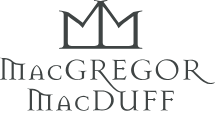From measuring you for your first kilt to making your all-important wedding wear, we live and breathe tartan every day. Here at MacGregor and MacDuff, quality and craftsmanship have been at the heart of what we do for more than 45 years, and we only work with mills who uphold these same standards. Much of our tartan is woven in the Scottish Borders at Lochcarron’s mill and we were delighted to pay our friends there a visit recently to see the process.

What does it take to make traditional tartan?
On our visit, we saw every stage that goes into creating the tartans that you know and love today. The yarn used to make our tartan comes from 100% Scottish wool and is sustainably sourced, something very important to us. Lochcarron are part of the Campaign for Wool, an initiative which champions the benefits of using wool in fabrics such as tartan for its sustainable and durable nature. Before the weaving process can begin, many of the yarns are custom dyed in the mill to ensure the exact colours we are looking for are spun into life. The mill keeps samples of each custom dyed yarn, meaning that future batches can be compared and matched to perfection, no matter if the colour was dyed two months or 10 years ago.

How was tartan made in the old days?
The process of weaving the tartan itself has changed very little over the years. Before machinery, the weaving process would have been carried out on a simple wooden loom. A skilled weaver would arrange each dyed wool thread into the exact sequence of the tartan's design and wind it onto the loom under even tension. They would then use a foot pedal, which would lift specific sets of threads so a hand-thrown shuttle could be passed horizontally between the threads. The traditional process required a significant level of skill and precision to master.

How do machines make tartan today?
Once modern machinery became available during the Industrial Revolution, the weaving process became much more efficient. Today, the specific yarns needed for a tartan are wound onto cones, measuring for the amount needed to avoid waste. The next stage is warping, which refers to the tartan pattern being constructed. The pattern sequence is repeated across the width of the warp and knotted at the end. The fabric really starts to come to life when it is transferred from the loom to the weaving machine. This is when the tartan sett starts to become recognisable. The team at the mill carefully monitor each machine to avoid any errors and keep the area clean of excess lint.

What happens once tartan has been woven?
Once woven, the tartan goes through a strict quality control process. Lochcarron's experienced workers are trained to spot even the smallest flaw in a tartan’s sett or thread colour. The tartan is then delivered to our head office here in Glasgow, ready to be transformed into kilts and trews in your exact measurements and specifications. Wearing your tartan with pride ensures that we preserve this ancient craft for future generations to enjoy for years to come. Thank you to the team at Lochcarron for taking the time to show us around and share their fascinating processes.

From weaving the tartan to perfectly positioning kilt pleats, the highest attention to detail goes into the making of each and every one of our items. To get your own piece of tartan, view our Tartan Finder and book an appointment in one of our stores to experience the magic of made-in-Scotland craftsmanship for yourself.

